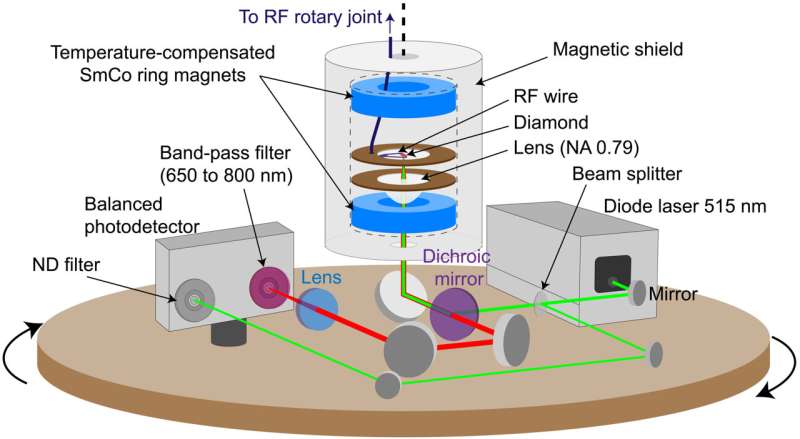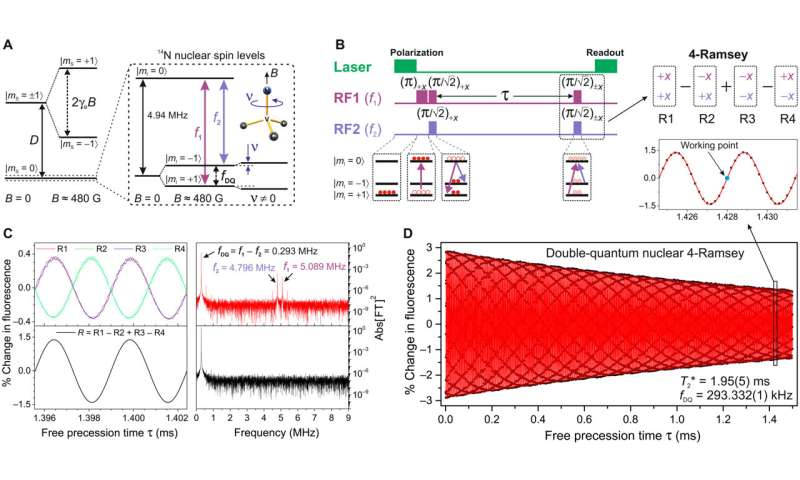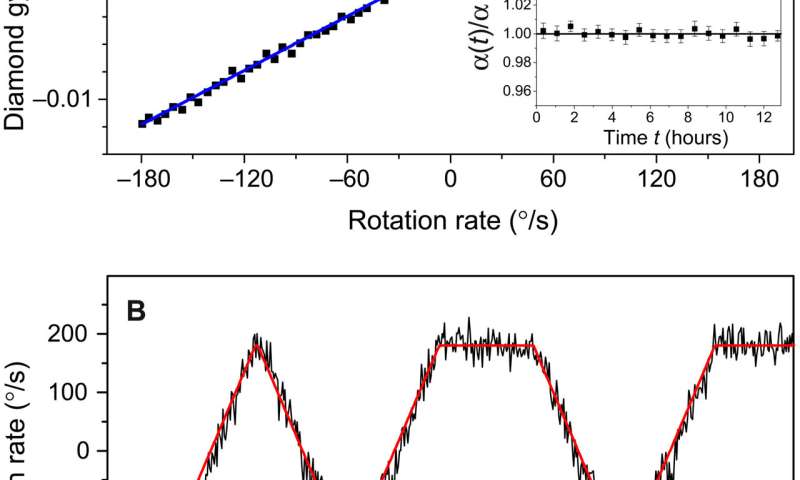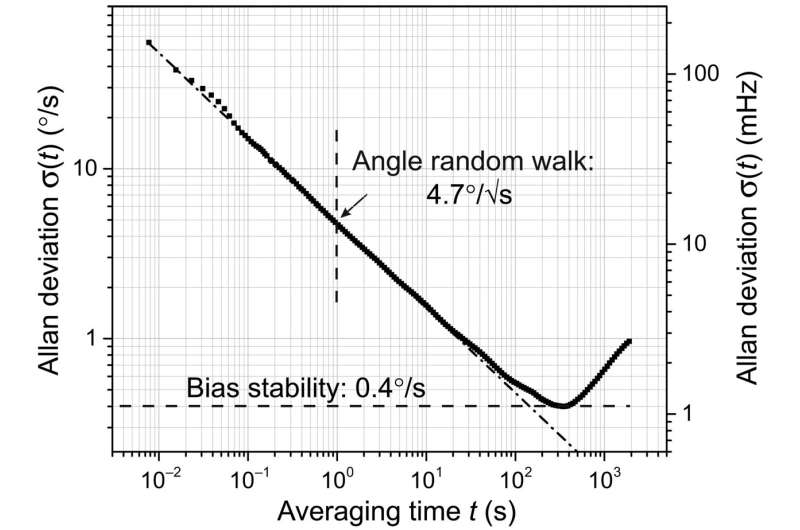November 5, 2021 feature
Demonstration of diamond nuclear spin gyroscope

In a new report now published in Science Advances, Andrey Jarmola and an international research team in physics and materials in the U.S. and Germany demonstrated the function of a rotation sensor based on the intrinsic to nitrogen-vacancy color centers in diamond. Nitrogen vacancy color centers are formed by nitrogen impurities that in diamond. The sensor used optical polarization and readout of the nuclei and a radiofrequency double-quantum pulse protocol to monitor the 14N nuclear spin precession. Rotation sensors or gyroscopes are typically used for navigation and automotive guidance. Among commercial sensors including and , emerging techniques include . These sensors can surpass commercial devices within the next decade relative to accuracy, robustness and miniaturization.
A diamond sensor
Nuclear spin gyroscopes are based on in diamond and are analogs of vapor-based NMR devices capable of functioning across a broad range of environmental conditions. A diamond sensor can function as a multi-sensor to report on magnetic field, temperature and strain, while serving as a , suited for . Jarmola et al. showed how a diamond NMR gyroscope directly provided information about the nuclear spin states without requiring precise knowledge of electron spin transition frequencies that are susceptible to environmental influences. With further improvements to the device, the team expect practical applications of miniature diamond gyroscopes during navigation.
Experimental setup
In the experimental setup, the team mounted the diamond sensor, green diode laser, photodetector and all optical components on a rotating platform regulated with a commercial rate table system. The diamond maintained a 400-µm thick single crystal plate with a nitrogen vacancy concentration of 4 parts per million. They produced the biased magnetic field using two temperature-compensated ring magnets. Jarmola et al. used an to illuminate a 50 µm diameter on the diamond with an 80 mW green laser light to collect nitrogen vacancy fluorescence. The scientists spectrally filtered the fluorescence with a and focused it onto one of the channels of a balanced photodetector for photodetection. They then delivered radiofrequency pulses for nuclear spin control using a 160 µm diameter copper wire placed on the diamond surface next to the optical focus. To prevent ambient magnetic field noises, the team placed the setup including the diamond and magnets inside low-carbon-steel magnetic shields.
Rotation detection principle and practical applications of the gyroscope

To detect rotation, the team measured the shift in the of 14N nuclear spins intrinsic to nitrogen vacancy centers in diamond. The scientists prepared the 14N nuclear spins in a superposition state. They then achieved the rotation detection presented in the work by measuring the frequency shifts with a . To demonstrate the practical implications of the diamond gyroscope across a range of rotation rates, the scientists performed a series of test experiments on a rate table. To begin with, they calibrated the gyroscope and then converted the fluorescence signal into a calibration rotation signal.

Outlook
In this way, Andrey Jarmola and colleagues developed a solid-state NMR gyroscope based on 14N nuclear spins intrinsic to nitrogen vacancy (NV) centers in diamond. Jarmola et al. noted the key features of the technique including optical polarization and readouts of the nuclear spins without using microwave transitions. By using temperature-compensated magnets, magnetic shielding and robust pulse protocols, the team reduced the influence of temperature and magnetic field drift to extend the long-term stability of the gyroscope to hundreds of seconds. The team intend to improve the sensitivity of the diamond gyroscope by extending the 14N nuclear spin coherence time. To improve the long-term stability, they also propose to reduce the ambient magnetic field drifts with better magnetic shielding.
More information: Andrey Jarmola et al, Demonstration of diamond nuclear spin gyroscope, Science Advances (2021).
J. S. Hodges et al, Timekeeping with electron spin states in diamond, �鶹��Ժical Review A (2013).
Journal information: Science Advances , �鶹��Ժical Review A
© 2021 Science X Network




















